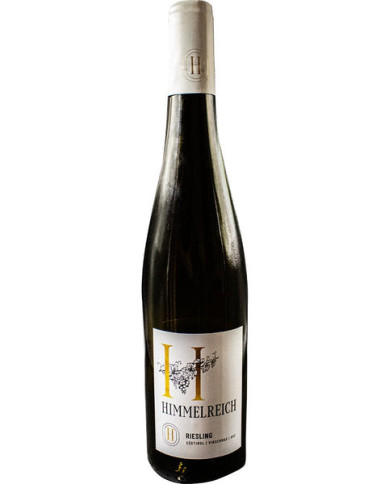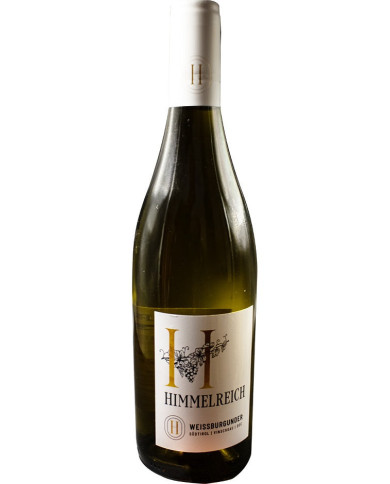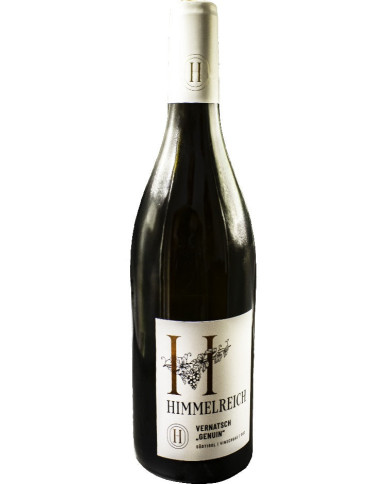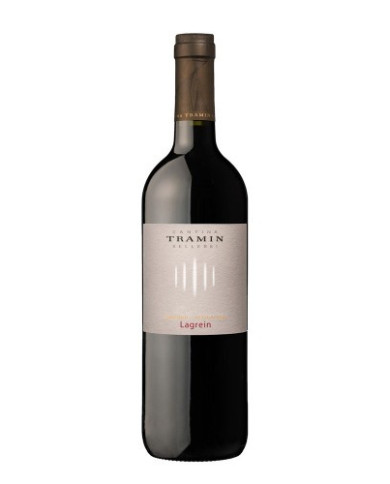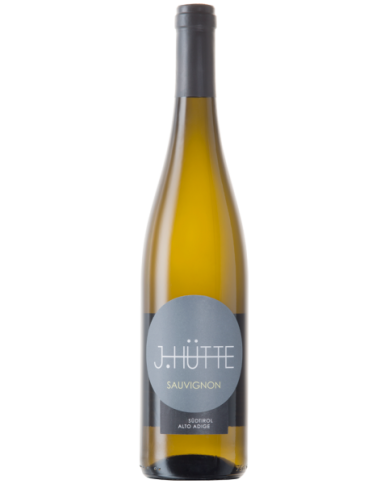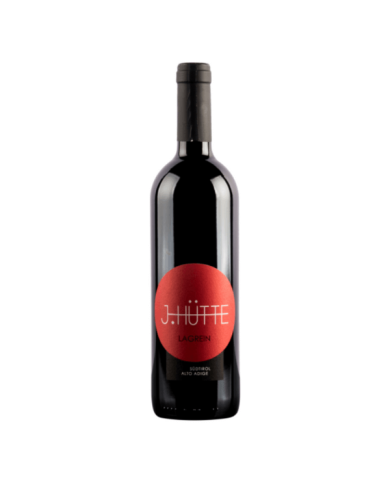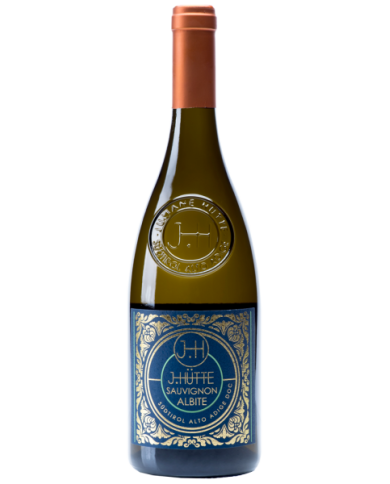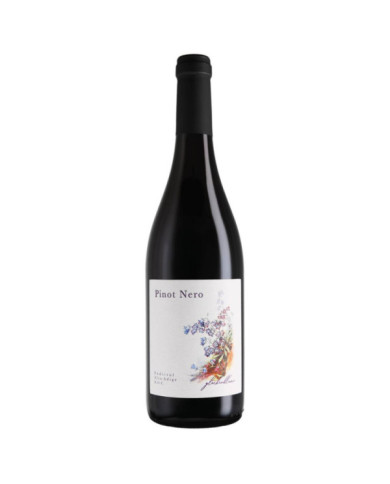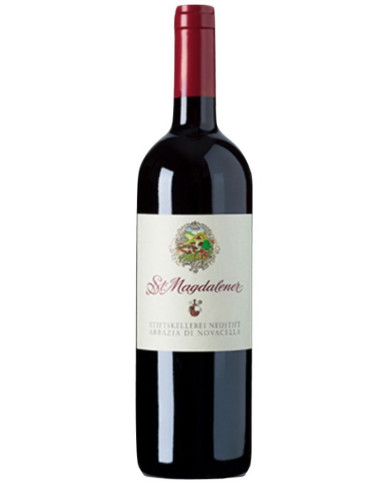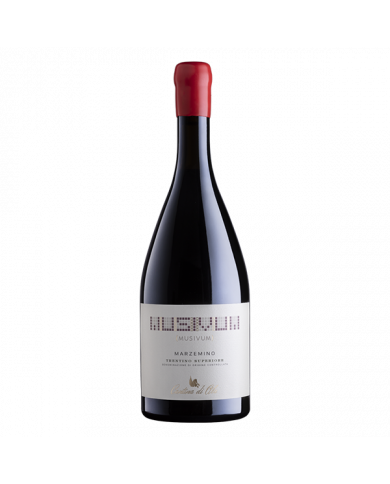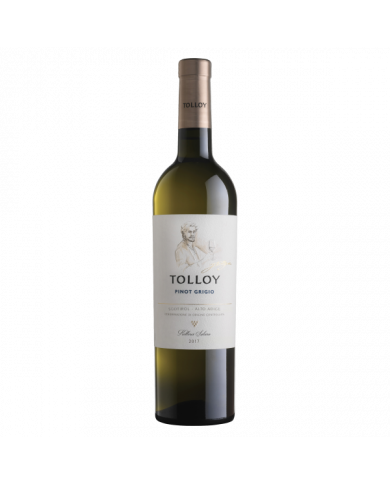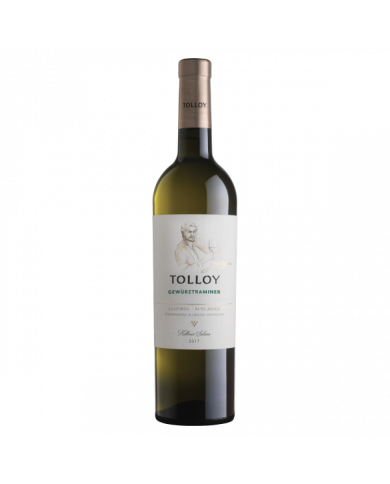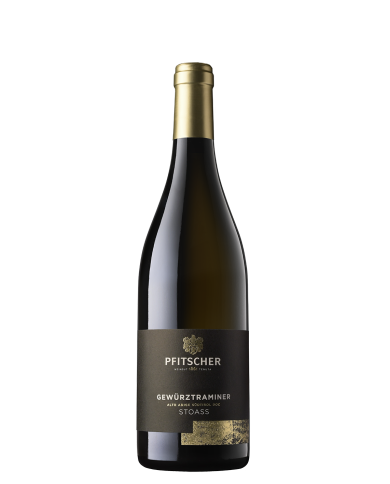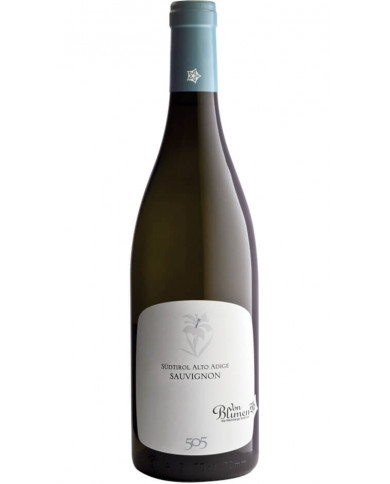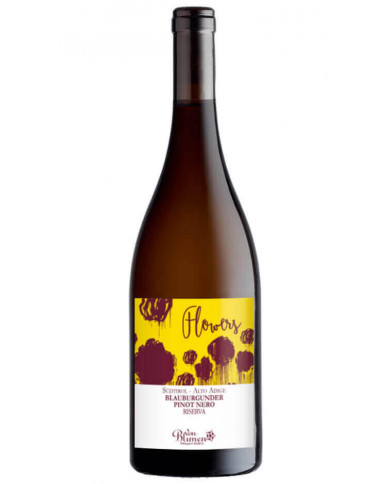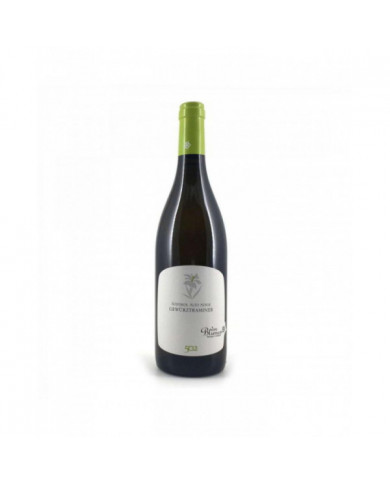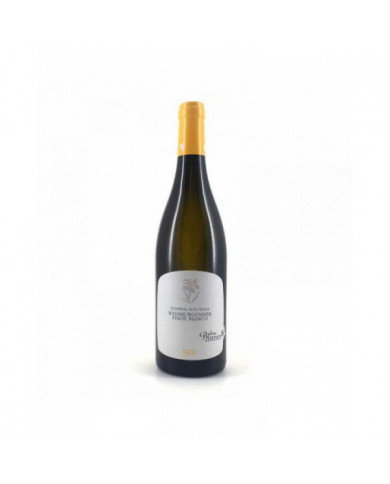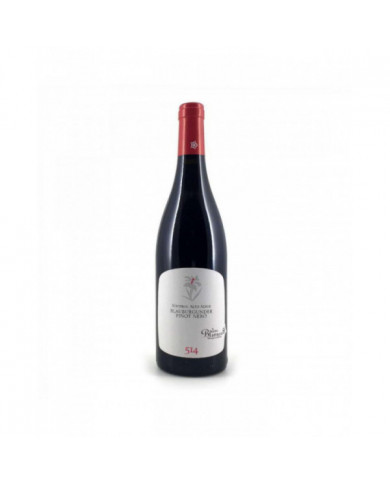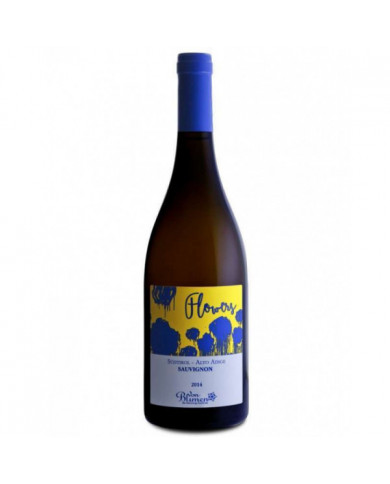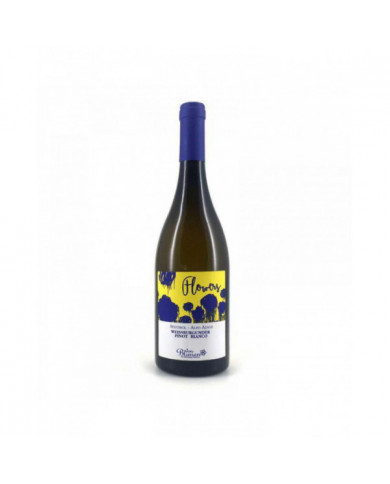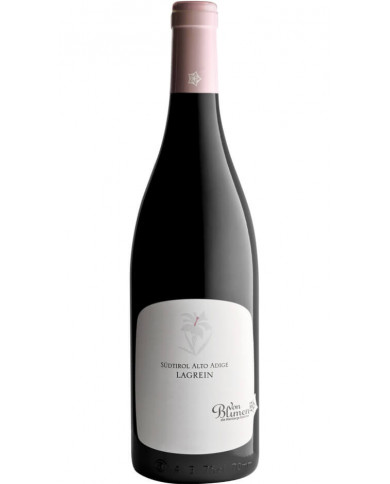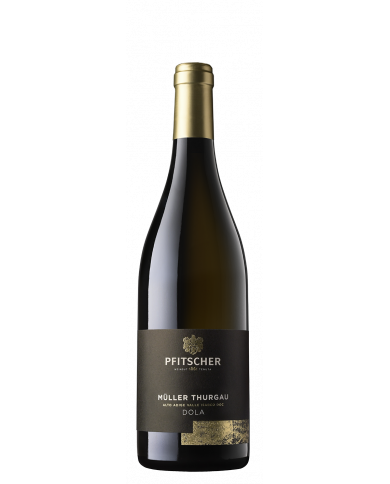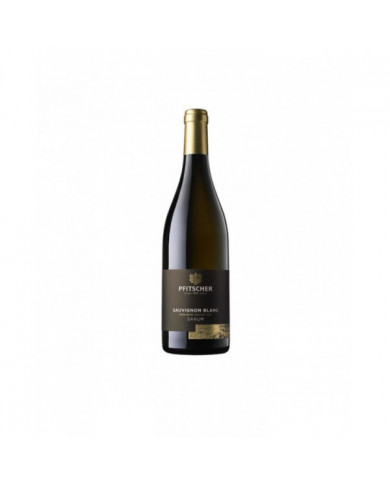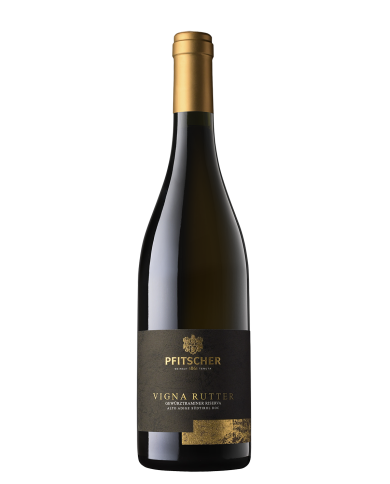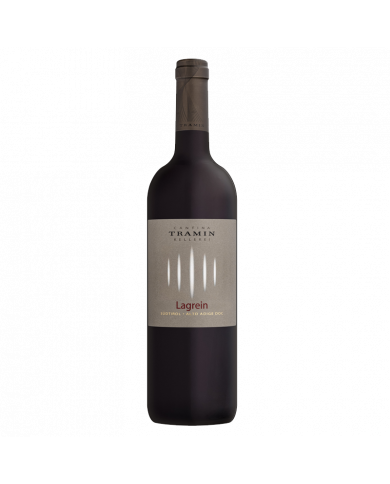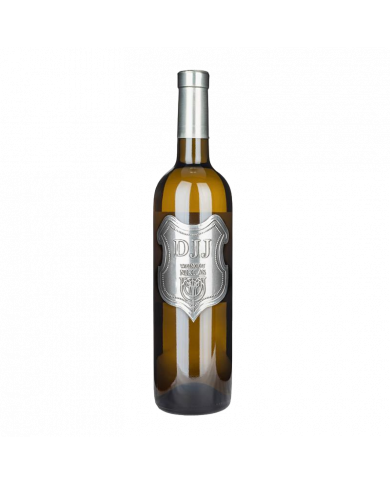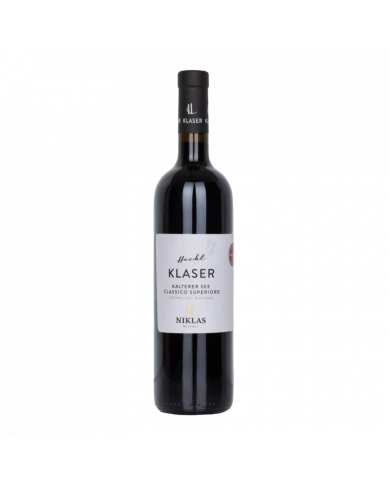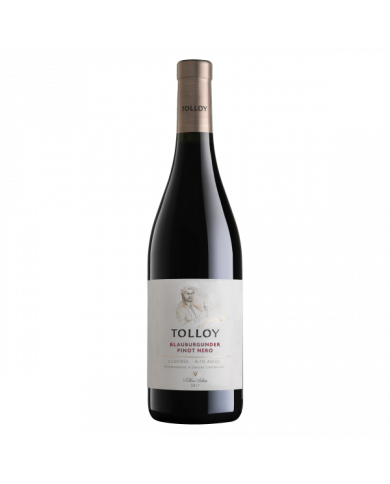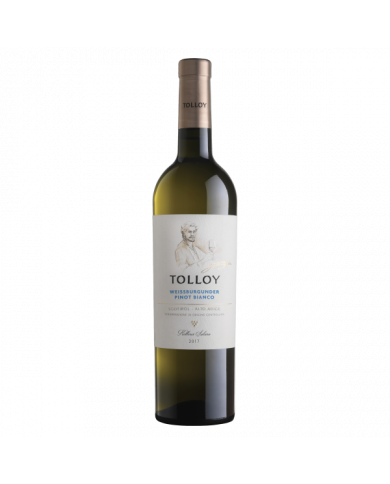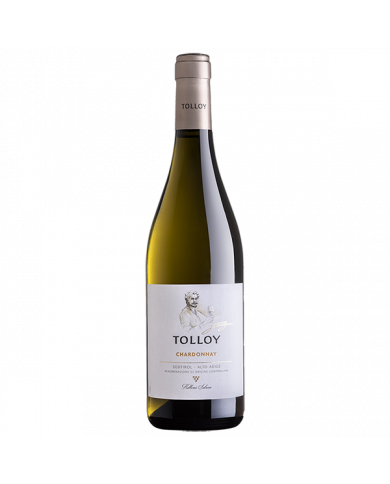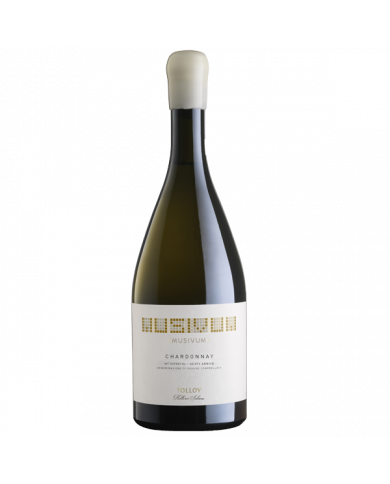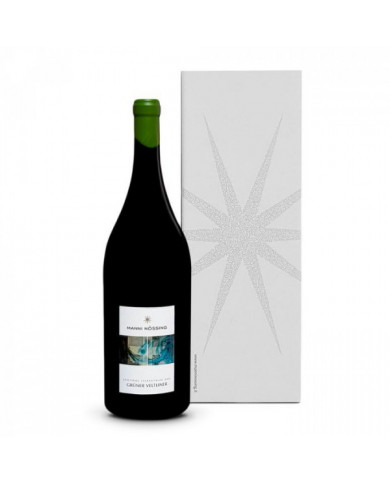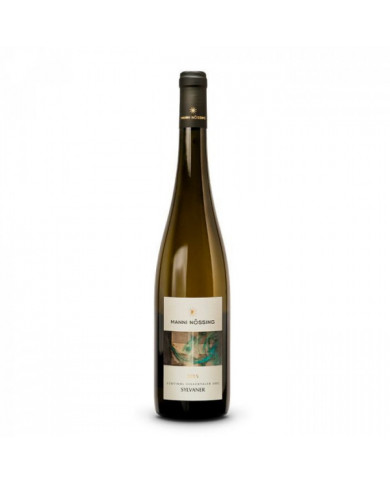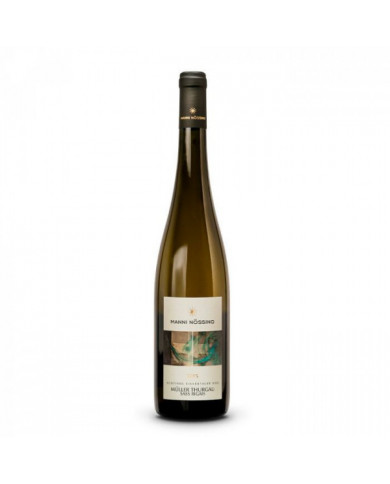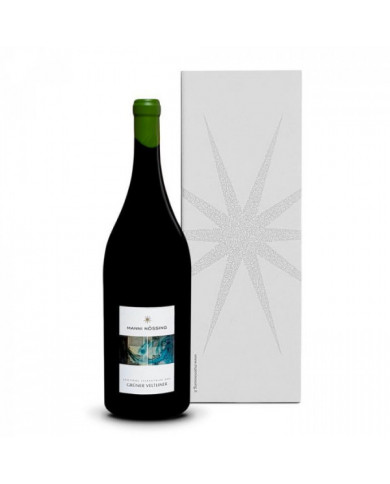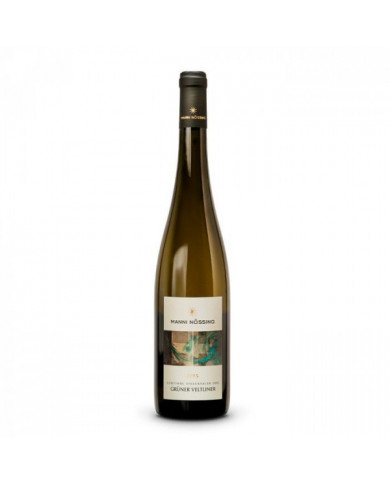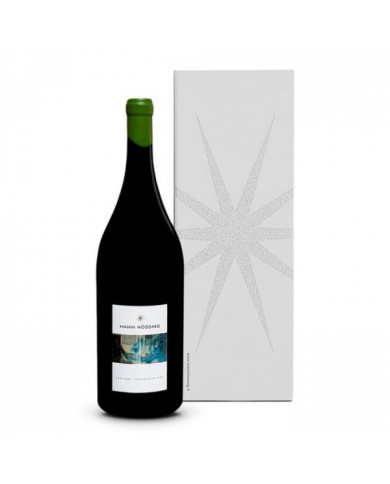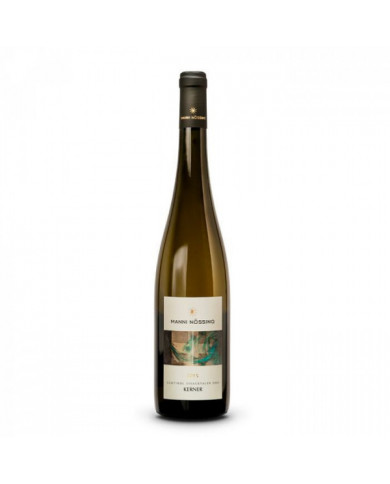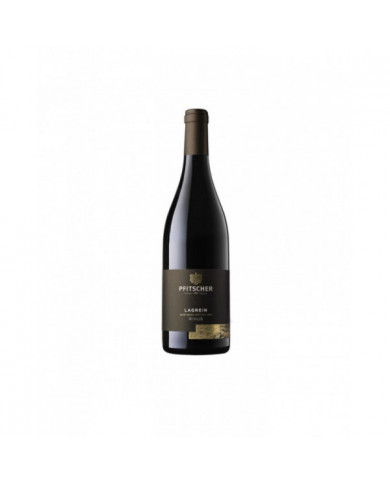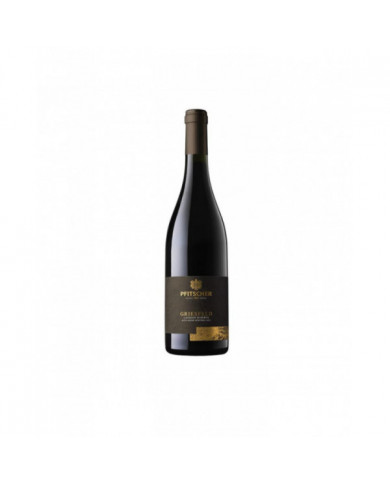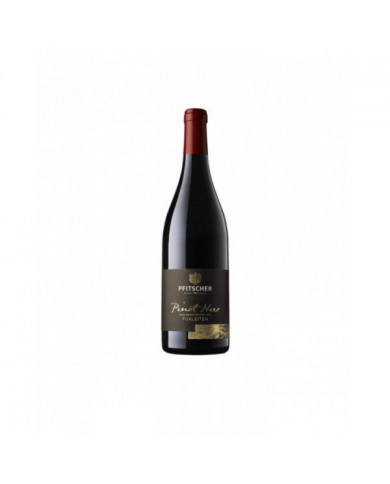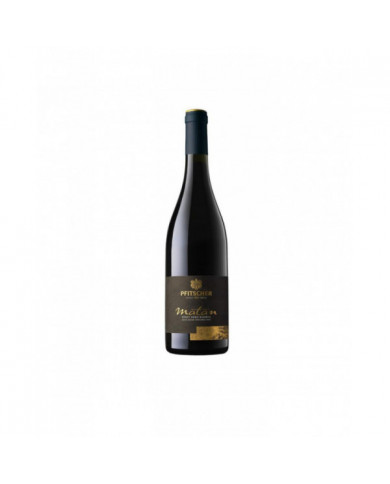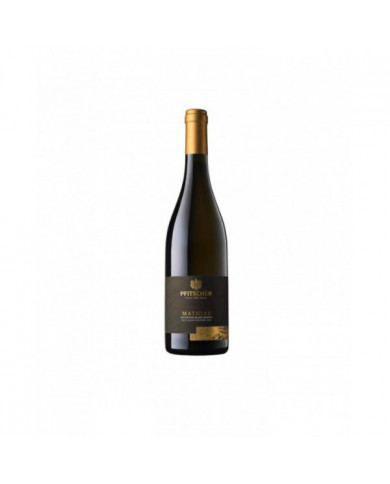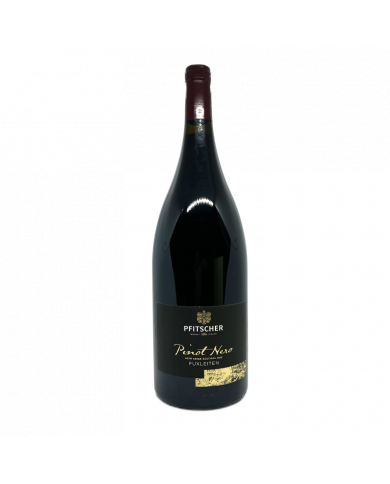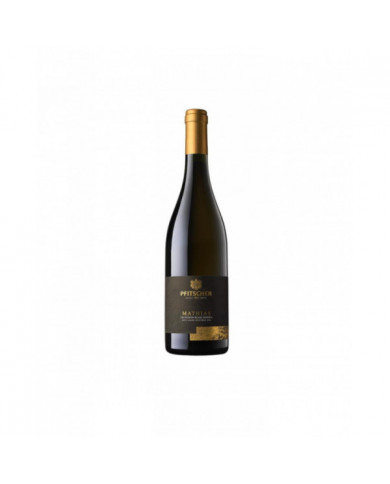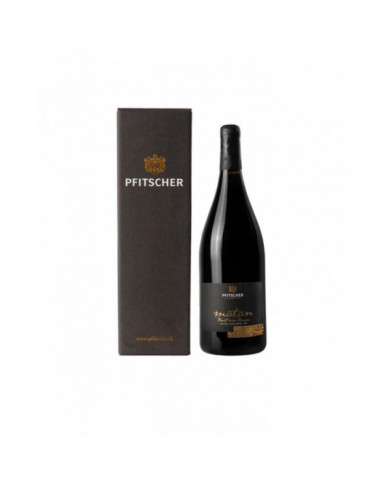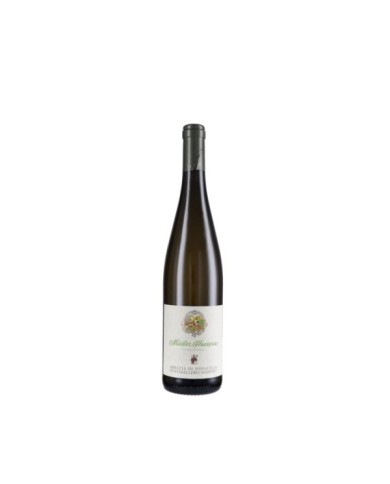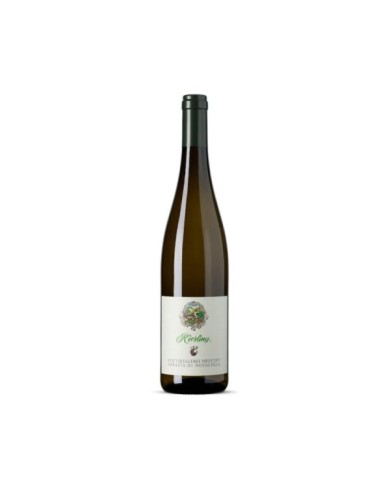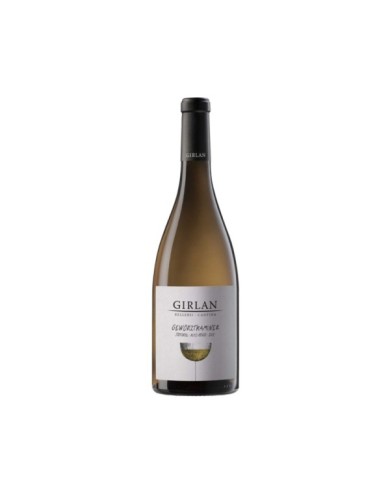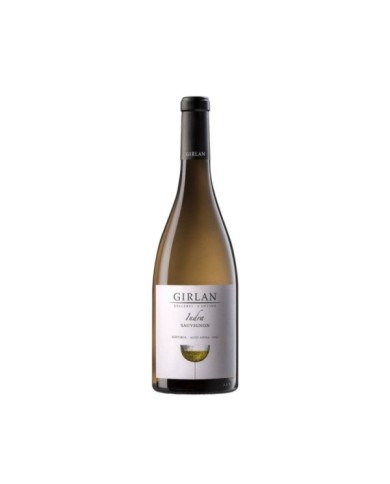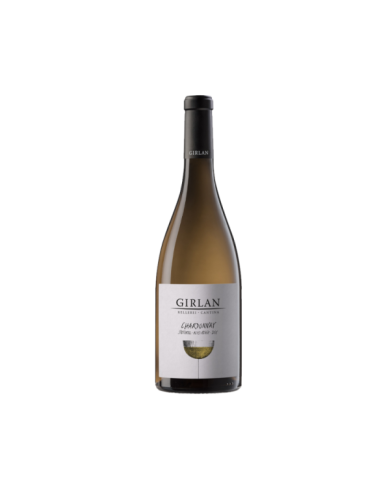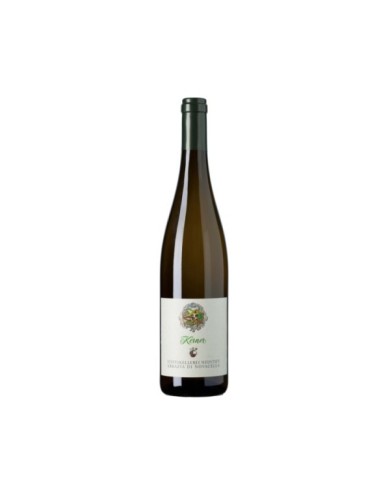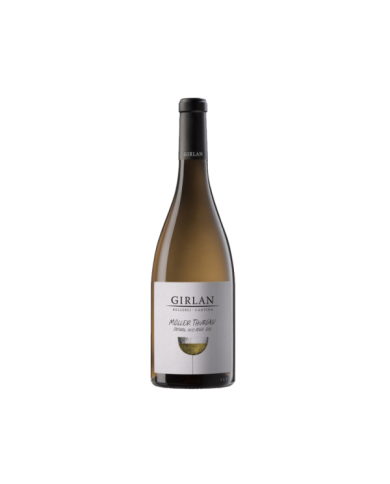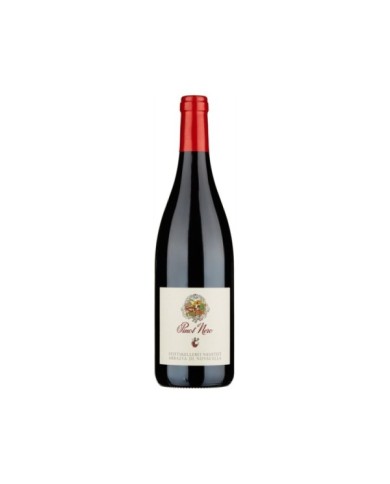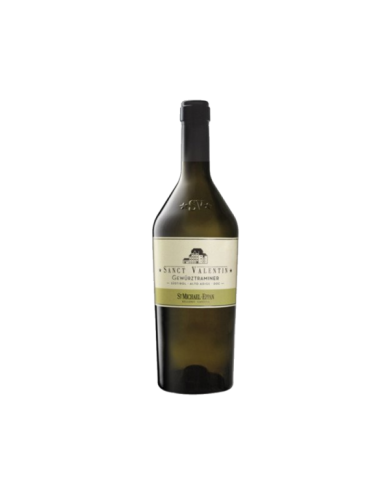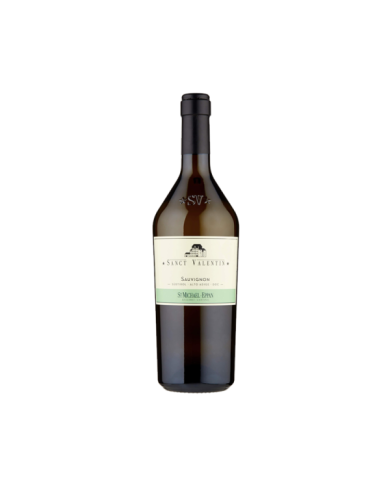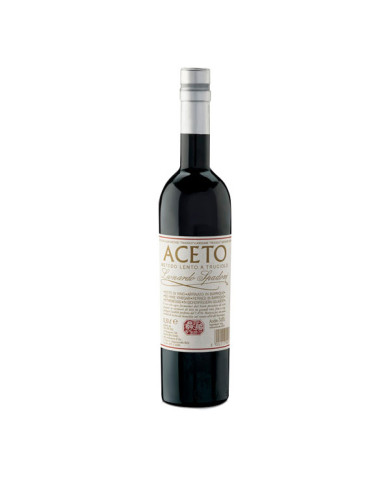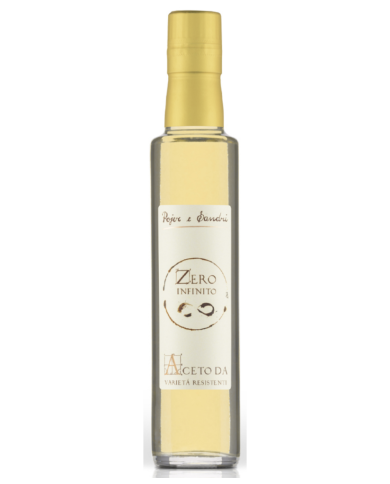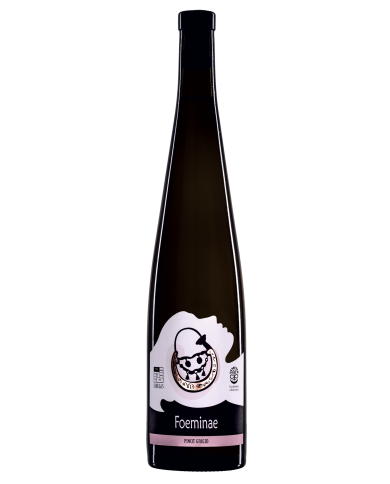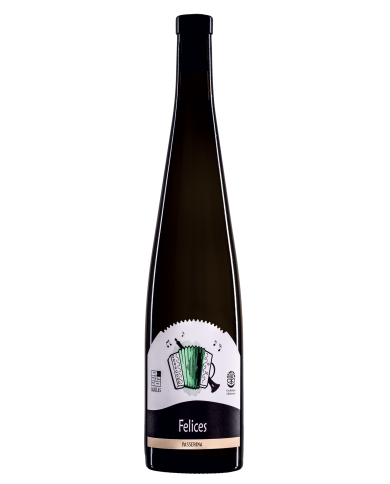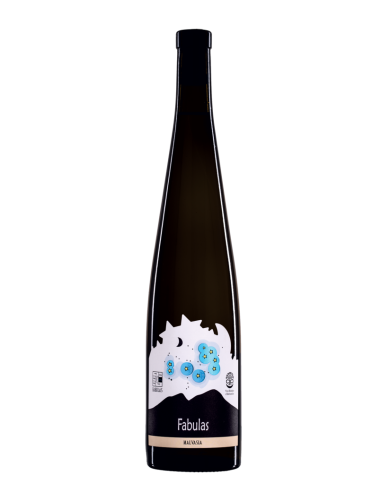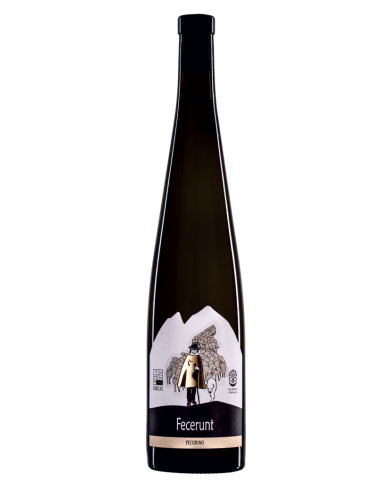This Riesling is an excellent white wine produced with grapes from the homonymous vine that grows in Val Venosta. The vines are grown on Monte Sole, where there is less rainfall than the entire western area of Alto-Adige. These particular climatic conditions, and the composition of the morainic soils, give the wines of the Himmelreich cellar their unique and unmistakable character. Its robe is of a bright yellow colour, with intervals of greenish reflections. As it enters the glass, Riesling releases a multifaceted bouquet, the first scent that is perceived is sweet and ripe yellow peach. Notes of pineapple with the right point of ripeness, prickly pears and fresh grapefruit follow immediately afterwards. As it passes, the palate is filled with minerality, its juicy and exotic taste is incomparably mineral and refreshing. This fresh white wine with a delicious taste goes perfectly with light appetizers, fish in general and seafood, but is also perfect with Asian dishes.
The result of a merger, which took place in 2001, between the Cantina Produttori Santa Maddalena and the Cantina Produttori Gries, this kaleidoscopic winery offers an incredible range, complete in the multiplicity of products and refined in the interpretation of the territory. The quality standard is truly impressive and does not fail to satisfy any palate, even the most demanding one, with the right attention to both native and international vines. A splendid example of quality is this Sauvignon, a semi-aromatic vine, characterized by a great variety of aromas, here incredibly enhanced by the warm, sandy soils and the breezy climate, which constitute the ideal terroir for a great wine.
With a rich range of labels with attention to the smallest details, the J.HÞtte winery, in the province of Bolzano, has managed in a short time to reach a substantial production volume of out of the ordinary quality, which sees the coexistence of native grapes of the area, such as Moscato Giallo , Lagrein and GewÞrztraminer with the international Chardonnay, Pinot Noir and Sauvignon. A mix of sandy and morainic soils, accentuated temperature variations and the support of the Bolzano winery combine to create measured and incisive wines, elegant and refined as only South Tyroleans can be.
Rich in sodium, albite is a typical mineral of the Alps, in particular of Valle d'Aosta, Piedmont and Alto Adige, where it finds the ideal subsoil for its development, proving to be a faithful ally for the vine. This Sauvignon is proof of this, presenting itself as the perfect synthesis between territory, climate and grape variety, thanks to its typicality which, in combination with albite, gives life to an authentic, complex and characterful label, capable of perfectly combining, to the gentleness of citrus and floral tones, an important structure and a strong minerality.
In the southernmost part of the Trentino Adige valley, where the Little Dolomites and the Baldo chain accompany Lake Garda in its expansion towards the Venetian plain, the vineyards of the Ala cellar are located; a land rich in memories, which was the scene of disputes between the Austrian empire and the most serene republic of Venice. It was thanks to these relationships and the consequent commercial exchanges of the people who populated it that Marzemino arrived in this land from the distant and suggestive Asia Minor.
Produced only with grapes from its own vineyards grown in South Tyrol in the valley floor and on the low hills. 100% Pinot Gris with traditional vinification in white at a controlled temperature around 18-20°C.
Produced only with grapes from our vineyards grown in Alto Adige on the medium hill in Pochi di Salorno. It is characterized by small bunches with pinkish berries tending towards bronze. With a distinctly aromatic taste, it is distinguished by the typical varietal aromas, softness and balance. White vinification with cold maceration and fermentation at 18-20 °C.
For more than a century this vine, originally from France and precisely from the Loire Valley area, has been grown on the hills of Alto Adige. The grape harvest takes place by hand, as in the past, starting from the beginning of September. After a gentle destemming, the grapes undergo a short cold maceration in a stainless steel press. The alcoholic fermentation takes place in steel tanks at a controlled temperature. At the end of alcoholic fermentation, the wine is kept in contact with the lees, in stainless steel containers for about 6 months. The Sauvignon has a yellow color with light green reflections. On the nose the scent is fresh, with extravagant hints of nettle, pepper, tomato leaves and anise. On the palate the flavor is intense and persistent with a good aroma and a savory and gritty acidity. A versatile goblet that goes perfectly with all courses at the table and after the first sip it will take you back to the unspoiled nature on the slopes of Monte Corno.
The Pinot Noir grape variety is considered among the most noble red grape varieties in the world and also the most difficult to interpret. The origin of this vine is believed to be attributed to the French region of Burgundy. Flowers is the name chosen by the winery to represent the spearheads of the Von Blumen project. Harvested in September, the grapes are then partially de-stemmed and crushed, and left to ferment with maceration on the skins in stainless steel tanks at a controlled temperature, for about 20 days. Subsequently, before bottling, it is aged for 12 months in French oak tonneaux. In the glass the color is a bright ruby red. The bouquet is intense and broad on the nose, ranging from sweet nuances of red and black fruits to fragrant spicy scents. On the palate it is enveloping and complex, with a mature and long-lasting tannic texture in the mouth. A wine of exceptional drinkability and character, excellent in combination with red meat dishes, medium and long-aged cheeses and traditional main courses of South Tyrolean cuisine.
The name Traminer appears for the first time in 1349 in Konrad Megenberg's "Book of Nature". The origins of this vine are uncertain; some believe they are in Alsace, others in the town of Termeno (Bolzano), still others in Wurttemberg, and finally in the Reno valley. The grapes are harvested manually in boxes. After a delicate destemming, cold maceration follows at a temperature of 12°. The alcoholic fermentation takes place in steel tanks at a controlled temperature; at the end of alcoholic fermentation, the wine is kept in contact with the lees, in stainless steel containers for about 6 months. In the glass it has an intense straw yellow color. On the nose, the aroma is intense and varied with aromas ranging from yellow pulp fruits, lychee, rose, acacia flowers and saffron. On the palate it immediately proves to be a wine of great structure and balance based on sapid and fresh notes, supported by a never invasive softness and characterized by delicious almond nuances. An eclectic goblet that is excellent on the table as an aperitif or to accompany shellfish dishes, ethnic cuisine and spicy flavours.
The Pinot Noir grape variety is considered among the most noble red grape varieties in the world and also the most difficult to interpret. The origin of this vine is believed to be attributed to the French region of Burgundy. The grape harvest is manual, as it was once done. After a delicate destemming and crushing, fermentation follows with maceration on the skins in stainless steel tanks at a controlled temperature. To extract color and aroma from the skins, several pumping overs are carried out and finally the maturation takes place in large wooden barrels. In the glass the color is a pale ruby red. The nose is intense and seductive with notes of raspberry, cherry, blackberry, violet and various spices. On the palate it is warm and enveloping, with lively notes of undergrowth. Thanks to its harmony, bringing this Pinot Noir to the table with red meat dishes, medium and long-aged cheeses and stewed fish will be a guaranteed success.
For more than a century this vine, originally from France and precisely from the Loire Valley area, has been grown on the hills of Alto Adige. The grape harvest takes place by hand, as in the past, starting from the beginning of September. After a gentle destemming, the grapes undergo a short cold maceration in a stainless steel press. The alcoholic fermentation takes place in steel tanks at a controlled temperature. At the end of alcoholic fermentation, the wine is kept in contact with the lees, in stainless steel containers for about 6 months. The Sauvignon has a yellow color with light green reflections. On the nose the scent is fresh, with extravagant hints of nettle, pepper, tomato leaves and anise. On the palate the flavor is intense and persistent with a good aroma and a savory and gritty acidity. A versatile goblet that goes perfectly with all courses at the table and after the first sip it will take you back to the unspoiled nature on the slopes of Monte Corno.
Production notes Pinot Bianco ''Flowers'' is a white wine aged for 10 months in tonneaux. Malolactic fermentation can be total or partial. Tasting notes Pinot Bianco ''Flowers'' is a straw yellow white wine with green transparencies. Perfumes of white flowers and flint with vegetal notes in the background. Fresh and mineral taste of ripe pineapple, sage and anise.
Precious light white wine, characterized by a slight acidity and a fruity bouquet. The nose captivates with delicate notes of nutmeg and stone fruit. The clear yellow-green color of this dry white wine captivates with its fruity and intense flavour.
White wine with a straw yellow color and an unmistakable and intense aroma of gooseberry, currant, elderberry, lilac and peach, coming from vines grown on calcareous soils of glacial origin. The nose has an intense and fruity aroma, while the palate is dry, with delicate acidic notes.
Pfitscher's GewÞrztraminer Riserva comes from a single selected vineyard, "Rutter", at an altitude of 300 meters above sea level in Egna.
A long winter postponed the awakening of the vine to early April. A drop in temperatures after budding also delayed flowering. Subsequently, the weather remained capricious with a hot June and a humid July which laid the ideal foundations for the start of the maturation. August showed its best side with sunny weeks and exceptionally low night temperatures. Despite some brief downpours at the end of September/beginning of October, the harvest, which began with a delay of approx. ten days than usual and characterized by clearly lower than average volumes, it was marked by numerous warm days and increasingly colder nights.
TypeRed wine Vintage2021 Capacity0,75 l CountryItaly Gradation13° RegionTrentino A. Adige ClassificationD.O.C. Grape varietySchiava
Produced only with grapes from its own vineyards grown in Alto Adige on the hill of Pochi, a hamlet of Salorno. Traditional red vinification at controlled temperature around 25°C with frequent pumping over, punching down and partial aging in small oak barrels for about 10 months.
Produced only with grapes from our vineyards grown in Alto Adige on the medium hill in Pochi di Salorno. It is characterized by small bunches with pinkish berries tending towards bronze. With a distinctly aromatic taste, it is distinguished by the typical varietal aromas, softness and balance. White vinification with cold maceration and fermentation at 18-20 °C.
Produced only with grapes from its own vineyards grown in South Tyrol in the valley floor and on the low hills. 100% Pinot Gris with traditional vinification in white at a controlled temperature around 18-20°C.
Produced only with grapes from its own vineyards grown in Alto Adige on the medium hill around Salorno. Traditional white vinification with partial cold maceration on the skins.
Chardonnay is one of the international grape varieties that best adapts to the environmental and climatic characteristics of Alto Adige. Here it manages to express all its aromatic potential. The particular location of the vineyards, between 200 and 500 meters above sea level, gives this wine a wide range of scents and aromas and the strong temperature range allows the wonderful acidity and freshness to be preserved. The grapes are harvested by hand around mid-September and subjected to traditional vinification with brief contact on the skins to increase the extraction of the varietal aromas characteristic of the grape. Subsequently the must is subjected to fermentation at low temperature
The production area chosen for the Chardonnay Musivum is located in Alto Adige and includes various locations: mainly in the municipality of Salorno, MagrÃĻ and Egna. The characteristics of the area, inclined to maintain high acid content, are ideal for the cultivation of Chardonnay which manages to reach high sugar levels. Another peculiarity of this area, ideal for growing grapes, is the microclimate characterized by good wind â which avoids dangerous stagnation of humidity and guarantees rapid drying of the grapes after the rains â and by an insolation throughout the day. Production begins with a slightly delayed manual harvest to enhance the aromatic richness of this variety. In the Cellar, the individual containers are distinguished on the basis of the characteristics of the grapes, so as to diversify the vinification process. All the grapes are cooled in the cell at 2-3°C. The following days those with a yellow/golden color are removed from the stalks and left to rest in the press for 4/5 hours in contact with the skins (cryomaceration) to increase the extraction of the aromatic precursors of this variety. The yellow/green colored grapes are instead de-stemmed and immediately subjected to soft pressing. From both portions a free-run must is obtained which is followed by natural decanting. The start of fermentation takes place in special stainless steel tanks, specially designed for the " Musivum " project, with selected yeasts and with a progressive and controlled increase in temperature from 14° to 18°C. Once fermentation has started, 65% of the volume continues its journey in the new barrique cellar: 50% in second passage oak barrels, where it remains for the refinement phase and the other 15% is aged in new French oak barriques at medium roast. The remaining 35% completes the fermentation in steel. During the refinement the 3 portions are kept separate, with frequent movements of the fine lees, up to 2 months before bottling, when they are brought together to amalgamate the different components, i.e. those fermented and aged in the various woods with the one fermented and aged in steel .
White wine with a straw yellow color and an unmistakable and intense aroma of gooseberry, currant, elderberry, lilac and peach, coming from vines grown on calcareous soils of glacial origin. The nose has an intense and fruity aroma, while the palate is dry, with delicate acidic notes.
This powerful crimson wine has a light violet note. The taste is rich in fine tannins, harmonious and full-bodied on the palate, with a velvety finish. Lagrein draws its character and its noble spicy notes above all from the refinement in small oak barrels.
Precious light white wine, characterized by a slight acidity and a fruity bouquet. The nose captivates with delicate notes of nutmeg and stone fruit. The clear yellow-green color of this dry white wine captivates with its fruity and intense flavour.
Long-lived and refined GewÞrztraminer with an intense fruity aroma of rose with notes of exotic fruits. White wine with shades of color from straw yellow to gold, delicate and balanced on the palate.
The grapes destined for the production of Cortazo come from the "Brenntal" vineyard in Cortaccia, famous as one of the warmest areas in South Tyrol. Robust and complex wine with refined tannins, ruby red nuances and light notes of violet and wild berries; on the palate it has a full taste, velvety finish.
Pinot Noir Matan grows in the most prestigious areas in Montagna for this vine. Thanks to the terroir, this wine is characterized by character, elegance, delicacy and aromatic notes. The considerable temperature range between day and night, which characterizes the ripening phase of the grapes, makes this robust dark red wine, with an aroma of wild berries, particularly structured.
White wine grown on soils of gray porphyry and sandy limestone powder. Straw yellow color and great potential for aromas with mineral hints of flint and an absolutely clear fruit. On the palate it is presented with great depth, precision and a decisive and persistent aftertaste.
The intense aroma of red and dark berries and violets is typical of our cultivation area in the mountains, which is considered one of the most suitable for this variety. In the mouth, this red wine unfolds harmoniously, full-bodied and persistent. In the glass, the wine shines in a beautiful ruby red.
White wine grown on soils of gray porphyry and sandy limestone powder. Straw yellow color and great potential for aromas with mineral hints of flint and an absolutely clear fruit. On the palate it is presented with great depth, precision and a decisive and persistent aftertaste.
Pinot Noir Matan grows in the most prestigious areas in Montagna for this vine. Thanks to the terroir, this wine is characterized by character, elegance, delicacy and aromatic notes. The considerable temperature range between day and night, which characterizes the ripening phase of the grapes, makes this robust dark red wine, with an aroma of wild berries, particularly structured.
Straw yellow, the nose expresses a delicate floral and fruity bouquet, characterized by strong citrus and tropical hints. On the palate it is slightly aromatic, fresh and savory, incisive and persistent.
Excellent as an aperitif, it goes well with light appetizers, salads, fried fish.
Straw yellow color to the eye, bright and clean. The nose is deep and aromatic, rich in scents reminiscent of ripe tropical fruit and yellow flowers. Secondly, the bouquet is completed by citrus nuances and mineral nuances. The taste is long and consistent with the sense of smell, with good body and good balance. Versatile in combinations, it accompanies aromatic and tasty preparations. Try it together with the Venetian liver.
Brilliant straw yellow to the eye. Intense on the nose with notes of peach, citrus, spring flowers and elderberry. Full-bodied taste, which rests on a lively freshness and on the typical flavor.
Fragrant white to combine with first and second courses of seafood, vegetarian dishes and spicy recipes of oriental cuisine.
Girlan 's Chardonnay is a young and fresh white wine from South Tyrol, with excellent balance and versatile elegance. The soft and refreshing sip, enlivened by aromas of yellow fruit and wildflowers. Ideal with fish-based appetizers and delicate dishes.
Girlan 's Muller Thurgau is a light and fresh white wine that ferments and ages exclusively in stainless steel tanks. It comes from two different plots, one rocky in the Adige Valley and the other sandy in the Isarco Valley. The result is a delicate, fragrant and slightly aromatic white, with fine notes of nutmeg
Brilliant straw yellow, the nose expresses aromas of wild sambuca and figs and a slightly spicy trace. In the mouth it is fine, decisive, dry and persistent. Of good acidity, it closes with an extremely clean finish on the fruit.
Excellent as an aperitif, the Sauvignon Sanct Valentin is an ideal white wine to accompany fish-based appetizers with delicate sauces or local cheeses, not too mature.
Alto Adige DOC: A Wine of Excellence in a Region of Great Traditions
Wine is a traditional drink that has been produced around the world for centuries. Italian wines have an international reputation for quality and excellence. One of the places in Italy known for the production of quality wines is Alto Adige. South Tyrol is a region in northern Italy that extends along the Val di Non and the Adige and Isarco valleys. The region is rich in history, tradition and, of course, wines.
South Tyrol is one of the oldest wine regions in Italy and today it is one of the most popular. The region is also home to numerous DOCs, such as Alto Adige DOC, Alto Adige Val Venosta DOC, Alto Adige Lagrein DOC and Alto Adige Teroldego Rotaliano DOC. The DOC Alto Adige is one of the most important DOCs in northern Italy and is a high quality product.
What is the South Tyrolean DOC?
The DOC Alto Adige is a controlled denomination of origin. It is a wine produced in the Adige and Isarco valleys, in Alto Adige, and is considered one of the most appreciated quality wines of the region. The DOC Alto Adige is a white, rosÃĐ or red wine which is produced with grapes grown in the Adige and Isarco valleys. The Alto Adige DOC is produced with local grapes, such as MÞller Thurgau, Sauvignon, GewÞrztraminer, Chardonnay, Pinot Bianco, Pinot Grigio, Pinot Nero, Lagrein and Sangiovese. The DOC Alto Adige requires that the wine be produced with a maximum yield of 70%.
What is the history of the DOC Alto Adige?
The history of the DOC Alto Adige dates back to the early 1900s, when the region developed as one of the first wine regions in northern Italy. In 1965, the region obtained official recognition as DOC. Over the years, the DOC Alto Adige has become one of the most popular DOCs in northern Italy, thanks to the quality and excellence of the wines produced.
What are the wines produced in the DOC Alto Adige?
The wines produced in the DOC Alto Adige are white, rosÃĐ or red. The white wines produced in the DOC Alto Adige are mainly MÞller Thurgau, Sauvignon, GewÞrztraminer, Chardonnay, Pinot Bianco, Pinot Grigio and Pinot Nero. The rosÃĐ wines produced in the DOC Alto Adige are mainly Pinot Grigio, Pinot Nero and Lagrein. The red wines produced in the Alto Adige DOC are mainly Sangiovese, Lagrein and Pinot Noir.
Who are the most important producers of DOC Alto Adige wines?
The DOC Alto Adige is produced by numerous wine producers, including some of the largest and most renowned wineries in the region. Among the most important wineries are: Castel Sallegg , Cantina Tramin, Cantina Terlano, Castel Juval, Cantina MagrÃĻ and Cantina Kurtatsch. These cellars produce wines of excellent quality, appreciated all over the world.
What are the prices of DOC Alto Adige wines?
The prices of DOC Alto Adige wines vary according to the producer, the grapes used and the vintage. The wines produced in the Alto Adige DOC can be purchased at prices ranging from 10 to 30 euros per litre. However, there are also luxury products produced in the Alto Adige DOC which can cost up to 100 euros per litre.
To conclude, the DOC Alto Adige is a controlled denomination of origin which represents one of the oldest and most popular wine-growing regions in Italy. The wines produced in the Alto Adige DOC are of excellent quality, appreciated all over the world, and are also appreciated for their history and tradition. The DOC Alto Adige offers a wide range of quality wines, from white to red, suitable for all palates, from the most demanding to the least demanding.

